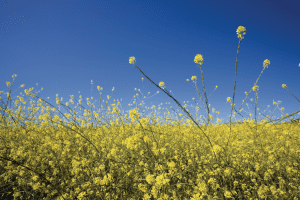Fallin’ for Pollen – Seasonal Allergies and How to Cope
By Chelsea Chambers
Article originally appeared in Thrive magazine

The seasons are changing, the leaves are ablaze with color, and the air turns cooler with each passing day — it is truly a beautiful time of year in New England. Despite the natural beauty, for the estimated 50 million Americans suffering from fall allergies, it’s a whole different story.
What can cause fall allergies?
The primary culprits of seasonal allergies can persist well into frost season — namely, mold and pollen. Mold can be found anywhere, anytime, indoors and out. Tree pollen, such as those from maple, oak and birch, can spread throughout the growing season. Grasses and low-to-the-ground weeds may also be a cause for concern.
Perhaps the biggest allergen of all is ragweed. This plant produces tiny yellow flowers with extremely high levels of pollen. The Asthma and Allergy Foundation of America estimates that between 10% and 20% of the American population (more than 40 million people) have an allergic reaction to ragweed specifically. And because ragweed pollen is so small and light, it can travel hundreds of miles by air. So even if you aren’t in close proximity, the allergy-riddled plant can still make its way into your home, eyes and sinuses.
What are the symptoms of allergies?
Allergy symptoms vary from person to person, which is why it can often be difficult to diagnose without proper testing. But on average, most people experience the following symptoms:
Most common symptoms may include:
- Sneezing
- Runny, stuffed or clogged nose
- Itchy, watery eyes that may be red in color
- Shortness of breath or chest tightness
- Cough
- Swelling of the face, tongue, eyes or lips
- Dark circles around the eyes
- Dry, cracked skin
- Headaches
Other less common symptoms may include:
- Nausea, vomiting or diarrhea
- Vertigo or dizziness
- Poor sleep quality resulting in grogginess
What can be done?
If you’ve already ruled out COVID-19 and can confirm your symptoms are allergy-induced, then there are options to find relief. Aside from a discussion with your health care provider and finding the right allergy medicine for you, there are a few things to try to reduce the impacts of seasonal allergies.
- Keep track of pollen counts. Pollen.com and the weather apps on most smartphones will calculate these totals for you.
- Stay inside on windy, dry days.
- Wear a mask when doing outside chores.
- Take off outside layers before going into your home to avoid spreading allergens indoors. Pollen can also adhere to clothes and skin.
- Avoid outdoor activities in the morning, as pollen counts are at their highest at this time.
- Vacuum floors often with a high efficiency or HEPA filter vacuum cleaner.
- Be sure to keep your windows closed and look into air filtration options, which have been shown to reduce the effects of some allergens.

